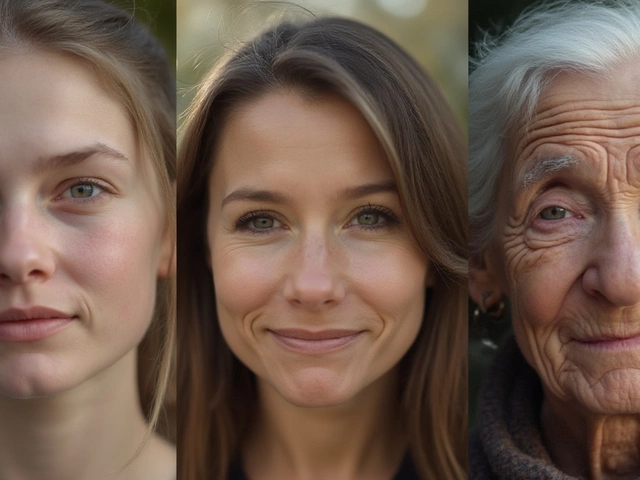If you think aging creeps up on you at a steady, slow pace, think again. It’s not a straight line. Scientists have tracked everything from skin thickness to muscle mass, and there’s a clear pattern—your body kicks aging into high gear at certain ages.
Most people are surprised to hear that your fastest aging spurt usually hits not in your 60s, but closer to your 40s. There’s even a study from Stanford that looked at blood proteins and found three actual spikes in aging speed—once around your late 30s to early 40s, then again in your early 60s, and one more push after 78. So, if you’ve ever felt like you suddenly went from fresh-faced to “when did these lines show up?” almost overnight, you’re not imagining it.
Knowing when these shifts happen isn’t just trivia—it gives you the best chance to jump in with preventative stuff when your body needs it most. Start paying attention in your late 30s, and your future self will thank you.
- Why Aging Isn’t Linear
- Ages When Things Start to Speed Up
- How This Shows Up in Real Life
- What Actually Makes Aging Speed Up
- What You Can Do To Hit Pause
Why Aging Isn’t Linear
The idea that you just get a tiny bit older every year and that’s it? Not true at all. Our bodies don’t age like a clock ticking along smoothly. Aging speeds up and slows down, depending on what’s happening inside you, and also outside—like stress, sunlight, and how you treat your body.
If you look at hard data, you’ll see what I mean. In 2020, researchers at Stanford dug into blood samples from people in their 20s all the way up to their 90s. They noticed three clear jumps when the body shows rapid aging: late 30s to early 40s, again in the early 60s, and another leap past 78. It’s like your body hits the aging “gas pedal” for a while, then eases off again.
If we zero in on aging speed, the first big change comes when hormone levels shift. Think visible stuff like wrinkles or gray hair, but also less obvious things like slower muscle recovery or changes in metabolism. These shifts don’t happen yearly—they come in waves.
- From 25–35: Most people look and feel pretty much the same. Collagen production starts to dip slowly, but it’s not dramatic yet.
- Late 30s–40s: Aging speeds up. Collagen loss picks up, and you might really start seeing fine lines, a slower metabolism, and changes in energy. For women, estrogen drops can trigger big changes.
- Early 60s: Another bump in the speed of aging. Things like muscle mass and bone density take a hit—and it’s more noticeable than before.
- Late 70s: Both men and women experience a third spike, with more rapid health decline, making prevention even more crucial earlier on.
This stop-and-go pattern doesn’t just affect looks—it also changes how your organs work and how well your body bounces back from stress and everyday wear and tear.
| Age Group | Aging Change Noted | What It Means |
|---|---|---|
| 25–35 | Small, slow changes | Minimal aging, easy to maintain health |
| 38–43 | First rapid spike | Skin, energy, metabolism step up aging |
| 60–65 | Second rapid spike | Muscle/bone loss, slower healing |
| 78+ | Third rapid spike | Faster overall decline |
Bottom line: Don’t just look at the calendar and assume aging is a slow burn. The jumps are real, and they give you a heads-up on when to focus on prevention, self-care, and new routines.
Ages When Things Start to Speed Up
You might expect aging to creep up slowly, but the truth is, there are a few years when things just accelerate. Like someone pressed the fast-forward button. Researchers have spotted set times in life where things change more quickly—these ages are worth paying attention to if you care about staying on top of aging speed.
Stanford scientists dug deep into blood protein markers and found there are three main "blitzes" when aging shifts up a gear. Here’s what’s wild—these aren’t just decades apart, they’re specific age clusters:
| Age Range | What Typically Changes Fastest |
|---|---|
| Late 30s to Early 40s | Collagen drops, metabolism slows, skin starts to thin, first big wrinkles appear |
| Early 60s | Muscle loss picks up, bone density falls, healing takes longer |
| After 78 | Brain aging speeds up, balance worsens, risk of chronic health issues rises |
So, that weird jump you feel when you hit 40 and suddenly care about eye cream? It’s real. The same thing happens again in your 60s—old injuries ache, sleep quality drops, you lose strength faster. After 78, things like memory and balance become bigger challenges, and this isn’t just about looks—your health risks multiply, too.
Nailing down these phases helps you pick the right habits and anti-aging tricks at the right time. It’s not about fighting nature, but about working smarter with the time you’ve got.

How This Shows Up in Real Life
The funny thing is, you probably don’t notice aging ramping up until it’s right in your face—literally. Your skin, joints, hair, and even how you bounce back from a bad night’s sleep tell the story. Peek in the mirror in your early 40s, and you might spot crow’s feet that didn’t exist a year ago. That isn’t just bad luck; it’s biology in action as your body loses collagen way faster than it did before.
For a lot of people, the most frustrating sign is how their skin starts behaving. Midlife is usually when you hear folks groan about “losing volume in my cheeks” or waking up to see dull, tired skin that no serum seems to fix. If you want a quick visual, check this out:
| Age Group | Typical Signs of Faster Aging | Why It Happens |
|---|---|---|
| Late 30s-40s | Fine lines, less skin bounce, slower hair growth | Drop in collagen, estrogen/testosterone shifts |
| Early 60s | Noticeable wrinkles, weaker muscles, fat redistribution | Lower growth hormone, slower cell turnover |
| After 78 | Fragile skin, memory & mobility changes | Decline in all repair systems |
It’s not just about looks. One of the first non-cosmetic things that trips up most people is how easy it gets to pull a muscle or hurt your back doing stuff that once felt like nothing. If you notice waking up sore more often, or that you take longer to recover from workouts (or, let’s be honest, from a night with too much pizza), you’re seeing faster aging speed in action.
- Skin isn’t bouncing back like it used to? Blame weakening collagen.
- Hair feeling thinner or starting to gray? Yep, that tends to pick up speed in your 40s and again after 60.
- Energy crashes or random aches showing up? That’s your body saying recovery takes longer now.
The wild thing is, these changes aren’t some slow, sneaky crawl—they happen in chunks. You can feel 35 one year and wake up feeling 45 the next. Recognizing these signs early means you can actually do something about it before the next jump kicks in.
What Actually Makes Aging Speed Up
Aging doesn’t just hit the gas out of nowhere—there are real reasons your body decides to age faster at certain times. Your DNA plays a role, but your everyday habits and environment have just as much say in how quickly this all happens.
The biggest player is stress. It cranks up something called cortisol, which isn’t just bad for your mood; it can break down collagen, make your skin sag, and throw your sleep cycle off. Lack of sleep itself is another huge culprit. Most experts agree that even missing out on just a few hours here and there, long term, makes you look and feel years older than you should.
Then there’s what you eat and drink. Diets high in sugar and processed foods can ramp up internal inflammation, which literally speeds up how quickly your tissues and skin cells break down. Studies show people who eat diets rich in veggies, healthy fats, and lean protein tend to have fewer of those sudden aging leaps.
Environmental stuff matters, too. Ultraviolet light from the sun is no joke—it’s responsible for up to 80% of visible skin aging. Pollution, smoking, and even sitting indoors all day with no movement chip away at your energy, skin, and muscle tone. If this sounds familiar, you’re definitely not alone.
| Factor | Impact on Aging | Can You Control It? |
|---|---|---|
| Chronic stress | Breaks down collagen, messes with hormones | Yes |
| Ultraviolet (UV) exposure | Causes most visible skin aging | Mostly |
| Poor diet (high in sugar) | Speeds up inflammation, skin breakdown | Yes |
| Sleep deprivation | Slows cell repair, lowers immunity | Yes |
| Genetics | Sets your "baseline" aging speed | No |
| Smoking | Accelerates wrinkles, age spots | Yes |
So if you want to slow down your aging speed, the biggest wins are in your hands—cut down stress, get outside (with sunscreen), eat real food, and treat your sleep like it’s non-negotiable. Genetics set the stage, but your choices decide how fast the play moves forward.

What You Can Do To Hit Pause
If you want to slow down the clock, you’ve got more control than you might think. Science backs up a bunch of small moves that add up—even if you already feel like you’re in the aging fast lane. Don’t worry, no snake oil here, just real, doable stuff.
Your daily routine is actually your secret weapon. The aging speed isn’t totally set in stone, and how you treat your body makes a difference over time. Here’s what experts everywhere keep saying works:
- Get real about sun protection. UV rays speed up skin aging more than anything else. A broad-spectrum SPF 30 (every single day, not just beach days) keeps your skin firmer and holds back sunspots and wrinkles.
- Don’t skimp on sleep. Aim for seven to eight hours. Consistent, deep sleep gives your cells time to repair and rebuild, which is your built-in night cream, basically.
- Move, even if it’s just a walk. Exercise slows muscle loss, boosts circulation, and helps you keep a healthy weight. Regular movement can even help balance hormones and reduce inflammation—major players in why aging speeds up.
- Load up on colorful fruits and veggies. Antioxidants in things like berries, spinach, and peppers fight off the stuff (free radicals) that ages you from the inside out. A Mediterranean-style diet isn’t just trendy; it’s been tied to fewer aging markers in studies.
- Moisturize like it’s your job. Dry skin makes wrinkles and fine lines pop out more. A good basic moisturizer helps your skin hold on to water so it stays bouncy longer.
- Keep stress in check. Chronic stress actually triggers changes in your body that make it age faster. Try whatever calms you—yoga, dog walks, funny podcasts—daily.
Thinking about treatments? Retinol, vitamin C serums, and in-office options like microneedling and lasers all have legit science behind them, but nothing beats starting with basics. No matter your age, these steps will help hit pause—or at least slow-mo—on the parts of aging you can actually control.


